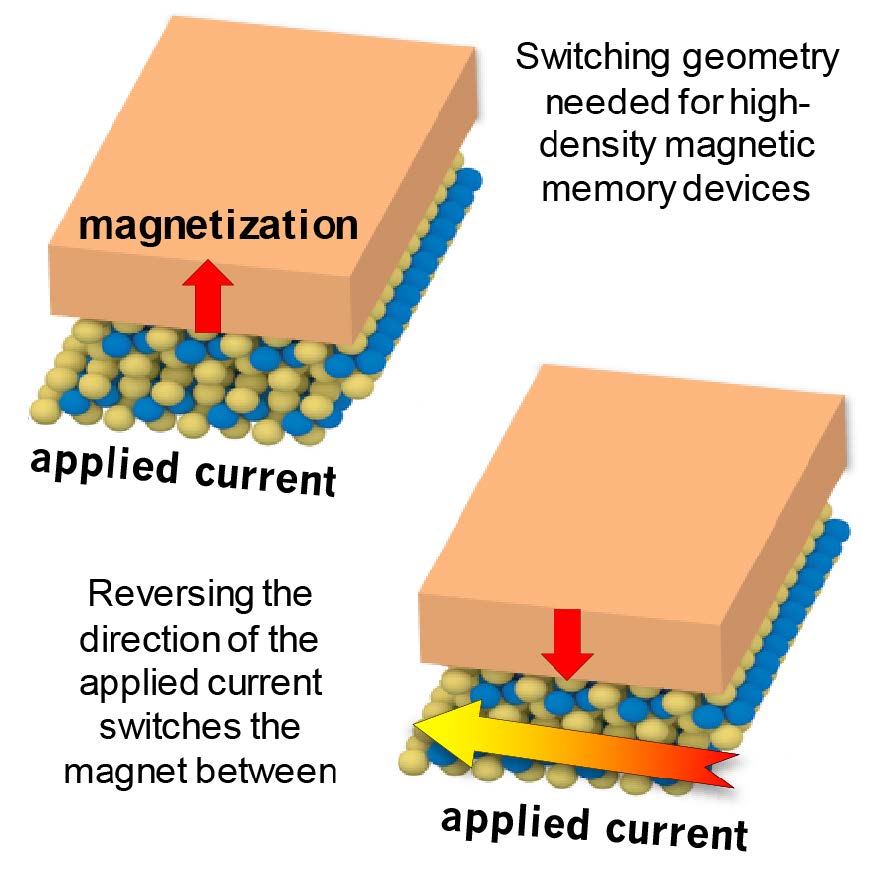Building on their growing expertise with interface materials, PARADIM researchers discovered a new mechanism for reorienting magnetization that is 10 times more energy efficient than prior techniques. An electrical current is passed through a low symmetry valleytronic material containing heavy atoms that is positioned under a magnetic layer. A phenomenon known as “spin-orbit coupling” allows this current to exert a strong torque on the magnetization. Ordinary heavy metals used for this purpose are really good at controlling the magnetization when it points horizontally, but not when it points perpendicular to the plane of the device (as shown in the figure), which is the geometry needed for high-density magnetic memories. By using a low symmetry valleytronic material, WTe2, we demonstrated that it is possible to rotate the “spin-orbit torque” into the direction needed to control vertically-oriented magnetic devices. In the coming year we will attempt to understand and increase the strength of this effect, so as to enable magnetic memories that can out-perform conventional electronics.

|
| Figure 1: The bilayer WTe2/Permalloy (Py) sample geometry. |
Technical details:
Recent discoveries regarding current-induced spin-orbit torques produced by heavy-metal/ferromagnet and topological-insulator/ferromagnet bilayers provide the potential for dramatically-improved efficiency in the manipulation of magnetic devices. Nevertheless, in experiments performed to date, spin-orbit torques have an important limitation – the component of torque that can compensate magnetic damping is required by symmetry to lie within the device plane. This means that spin-orbit torques can drive the most current-efficient type of magnetic reversal (antidamping switching) only for magnetic devices with in-plane anisotropy, not the devices with perpendicular magnetic anisotropy that are needed for high-density applications. We have shown experimentally that this state of affairs is not fundamental, but rather one can change the allowed symmetries of spin-orbit torques in spin-source/ferromagnet bilayer devices by using a spin source material with low crystalline symmetry. We use the low symmetry valleytronic material WTe2, a transition-metal dichalcogenide whose surface crystal structure has only one mirror plane and no two-fold rotational invariance. Consistent with these symmetries, we generate an out-of-plane anti-damping torque when current is applied along a low-symmetry axis of WTe2/Permalloy bilayers, but not when current is applied along a high-symmetry axis. Controlling spin-orbit torques by crystal symmetries in multilayer samples provides a new strategy for optimizing future magnetic technologies.
Full Citation: D. MacNeill, G.M. Stiehl, M.H.D. Guimaraes, R.A. Buhrman, J. Park, and D.C. Ralph, “Control of Spin–Orbit Torques through Crystal Symmetry in WTe2/Ferromagnet Bilayers,” Nat. Phys. 13, 300–305 (2017).
Return to: In-house Research Highlights







